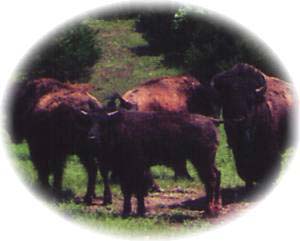Buffalo County, NE
 Although Nebraska Territory was not created until 1854, the area was already well-known as the main east-west route along the Platte River. Westward travel on the Oregon, Mormon, and California Trails had reached such proportions by 1848 that Fort Kearny was established to protect travelers on the trails.
Although Nebraska Territory was not created until 1854, the area was already well-known as the main east-west route along the Platte River. Westward travel on the Oregon, Mormon, and California Trails had reached such proportions by 1848 that Fort Kearny was established to protect travelers on the trails. In the fall of 1872, the village of Kearney Junction was formed paving the way for the City of Kearney to be incorporated a little over a year later.
The first courthouse of Buffalo County erected at Gibbon in 1873. In 1874, after considerable agitation for the relocation of the county seat, an election was held, and a majority was cast for the relocation of the county seat at Kearney. The incident which followed the results of that election is often referred to as "stealing the courthouse records." With the results of the election already in, the County Clerk, Joseph Scott, and his deputy, F.G. Keens, loaded the county records in a farm wagon, considerably after normal business hours and arrived in Kearney about 2:00 a.m. where they were hidden in the "Chandler Building" where the Telephone Company is today. Mr. Keens stood guard over the records for the rest of the night.
The Union Pacific Railroad donated a site for a new courthouse, and built a frame building which was not occupied until January of 1886. This building served as the Buffalo County Courthouse until a new county courthouse was built and completed in 1890. The frame courthouse was then moved to a new location on First Avenue and served first as a WCTU hospital and later as a home for the Veterans of Foreign Wars.
Complete histories of Buffalo County are exhibited and recorded at museum's in Kearney and Gibbon and The Great Platte River Road Archway Monument is a "must see" as the only museum that spans an interstate highway and brings the history of life along the westward trails in chronological dioramas putting you right alongside the pioneers and listening to their stories.
Explore Buffalo County
Cabela's
Cabela's oldest existing retail showroom, the 17,000-square-foot Kearney, Nebraska store, is filled with all the quality outdoor gear you expect from the World'
Kearney, NE Sporting VenuesJohn Pesek Sculpture
A famous native of Ravenna who at one time was the wrestling champion of the world and also trained racing greyhounds. His sculpture with two of his dogs is located north of the mini park on Grand Avenue.
Ravenna, NE MemorialsFort Kearny State Recreation Area
Campers will find south-central Nebraska's Fort Kearny State Recreation Area much to their liking. Once called Kearney County SRA, this recreational area boasts excellent camping facilities. The attractive 152-acre area was acquired by the Nebraska Game and Parks Commission in 1960
Kearney, NE State Recreation AreasGreat Platte River Road Archway Monument
The only U.S. attraction to span an interstate highway, the Great Platte River Road Archway Monument is a fantastic link to the past. Its eight stories span a distance where trappers, pioneers, the 49
Kearney, NE MuseumsSweetwater Mill and Kilgore Bridges
Sweetwater Mill Bridge In November 1908
Kearney, NE Historic BuildingsMuseum of Nebraska Art
The Museum of Nebraska Art houses the state's only collection of paintings, sculptures, drawings, and prints created solely by Nebraskans or artists concerned with Nebraska as the subject. Enjoy quality invitational and traveling exhibits as well as creative exhibits of the museum'
Kearney, NE MuseumsKearney Golf
Buffalo Ridge Golf Course - 2,960-yard, par 36, nine-hole public course on gently rolling hills northeast of Kearney. Open year round with rental carts and clubs. Green fees: Weekdays - $13.00; Weekends - $15.00. 7005 Avenue N 308-271-3233 Meadowlark Hills Golf Course - 6,485-yard, par 70, 1
Kearney, NE Golf CoursesJohn Barnd House
The John Barnd House, located in Kearney, is a large two-and-one-half-story frame dwelling built about 1892, and a good example of the Queen Anne style. Barnd came to Kearney in 1874, established a law practice, and later was elected Buffalo County judge for two terms. In 1888
Kearney, NE Historic BuildingsHistoric Frank House
The Frank House, built by George Washington Frank, was constructed in 1889. The three-story house listed on the National Register of Historic Places, is made of red Colorado sandstone, with English golden oak interior paneling and lumber, and hand carved woodwork and has seven fireplaces (10
Kearney, NE Historic HomesDr. A. O. Thomas House
The Thomas House was designed by Nebraska architect George A. Berlinghof in 1906 in the Neo-Classical Revival style. Dr. A. O. Thomas, a native of Illinois, was the first president of the Kearney State Normal School, now the University of Nebraska at Kearney.
Kearney, NE Historic BuildingsTri-City Storm Hockey Team
Hockey fever is sweeping the nation and the cities of Kearney, Grand Island, and Hastings are proud to join in. Part of the United States Hockey League, the Tri-City Storm took to the ice for the first time in 2000. A new 97,000-square-foot facility houses the new team and loyal fans.
Kearney, NE Professional Sports